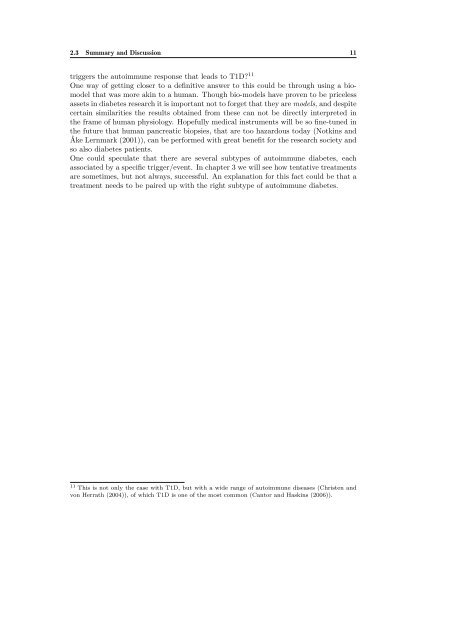- Page 1 and 2: - I, OM OG MED MATEMATIK OG FYSIK E
- Page 3 and 4: Exploring Treatment Strategies for
- Page 5: Preface iii questions that were out
- Page 8 and 9: vi Contents Significance of the Apo
- Page 10 and 11: List of Tables 5.1 summarizes the m
- Page 12 and 13: x List of Figures 8.3 Phase space p
- Page 14 and 15: xii
- Page 16 and 17: 2 Introduction In the following dec
- Page 18 and 19: 4 Introduction There are several sc
- Page 20 and 21: 6 Introduction because I had to mak
- Page 22 and 23: 8 Type 1 Diabetes and Its Etiology
- Page 27 and 28: 3 Prospects for Therapy - A Mini Re
- Page 29 and 30: 3.3 Gastrin 15 eration in situ Urus
- Page 31 and 32: 4 Mathematical Modelling The langua
- Page 33 and 34: 5 The DuCa Model In the following w
- Page 35 and 36: 5.3 The DuCa Model - An Appetiser 2
- Page 37 and 38: 5.4 The DuCa Model - Compartment Mo
- Page 39 and 40: 5.4 The DuCa Model - Compartment Mo
- Page 41 and 42: 5.4 The DuCa Model - Compartment Mo
- Page 43 and 44: 5.6 Our Compartment Model 29 migrat
- Page 45 and 46: 5.6 Our Compartment Model 31 a ✓
- Page 47 and 48: 5.7 Discussion of Marée et al. (20
- Page 49 and 50: 5.7 Discussion of Marée et al. (20
- Page 51 and 52: 5.8 Discussion of Parameters 37 Fig
- Page 53 and 54: 5.8 Discussion of Parameters 39 Par
- Page 55 and 56: 5.8 Discussion of Parameters 41 tha
- Page 57: 5.8 Discussion of Parameters 43 Fig
- Page 60 and 61: 46 The Intermediated Model The diff
- Page 62 and 63: 48 The Intermediated Model expected
- Page 64 and 65: 50 The Intermediated Model Stabilit
- Page 66 and 67: 52 The Intermediated Model restrict
- Page 68 and 69: 54 The Intermediated Model We see t
- Page 70 and 71: 56 The Intermediated Model paramete
- Page 72 and 73: 58 The Intermediated Model ✻ Ma(t
- Page 74 and 75:
60 The Intermediated Model 6.2 The
- Page 76 and 77:
62 The Intermediated Model ✻ Ma(t
- Page 79 and 80:
7 A Brief Introduction to Bifurcati
- Page 81 and 82:
7.2 The Hopf bifurcation 67 the gen
- Page 83 and 84:
7.3 Biological Relevance of Bifurca
- Page 85:
7.5 Locating the Fixed Points 71 Ev
- Page 88 and 89:
74 Bifurcation Diagrams and Analysi
- Page 90 and 91:
76 Bifurcation Diagrams and Analysi
- Page 92 and 93:
78 Bifurcation Diagrams and Analysi
- Page 94 and 95:
80 Bifurcation Diagrams and Analysi
- Page 96 and 97:
82 Bifurcation Diagrams and Analysi
- Page 98 and 99:
84 Bifurcation Diagrams and Analysi
- Page 100 and 101:
86 Bifurcation Diagrams and Analysi
- Page 102 and 103:
88 Bifurcation Diagrams and Analysi
- Page 104 and 105:
90 Bifurcation Diagrams and Analysi
- Page 106 and 107:
92 Bifurcation Diagrams and Analysi
- Page 108 and 109:
94 Bifurcation Diagrams and Analysi
- Page 110 and 111:
96 Bifurcation Diagrams and Analysi
- Page 112 and 113:
98 Discussion of the Bifurcation An
- Page 114 and 115:
100 Discussion of the Bifurcation A
- Page 116 and 117:
102
- Page 118 and 119:
104
- Page 120 and 121:
106 Expanding and Modifying the DuC
- Page 122 and 123:
108 Expanding and Modifying the DuC
- Page 124 and 125:
110 Expanding and Modifying the DuC
- Page 126 and 127:
112 Expanding and Modifying the DuC
- Page 128 and 129:
114 Expanding and Modifying the DuC
- Page 130 and 131:
116 Expanding and Modifying the DuC
- Page 132 and 133:
118 Discussion of the Expanded Mode
- Page 134 and 135:
120 Discussion of the Expanded Mode
- Page 136 and 137:
122
- Page 138 and 139:
124
- Page 140 and 141:
126 Bibliography Christen, U. and M
- Page 142 and 143:
128 Bibliography Notkins, A. L. and
- Page 144 and 145:
130 Bibliography Yu, J. and G. S. E
- Page 146 and 147:
132 Mathematical Appendices the com
- Page 148 and 149:
134 Mathematical Appendices in that
- Page 150 and 151:
136 Mathematical Appendices A.6 Dim
- Page 152 and 153:
138
- Page 154 and 155:
140 Additional Figures Figure B.2 P
- Page 156 and 157:
142 Additional Figures B.2 Eigenval
- Page 158 and 159:
144 Additional Figures Figure B.8 P
- Page 160 and 161:
146 Additional Figures B.3 Eigenval
- Page 162 and 163:
148 Additional Figures Figure B.14
- Page 164 and 165:
150 Additional Figures Figure B.16
- Page 166 and 167:
152 Additional Figures B.5 Eigenval
- Page 168 and 169:
154 Additional Figures Figure B.22
- Page 170 and 171:
156 Additional Figures Figure B.25
- Page 172 and 173:
158 matlab Code w(r+1)=w(r)+dw; g=w
- Page 174 and 175:
160 matlab Code end V_11(r)=E(1); V
- Page 176 and 177:
162 matlab Code n=675; w_5=0; dw_5=
- Page 178 and 179:
164 matlab Code M=M’; % end s_7(r
- Page 180 and 181:
166 matlab Code w_7,V_34,’.b’,w
- Page 182 and 183:
168 matlab Code M=M’; % M must be
- Page 184 and 185:
170 matlab Code %options = odeset(
- Page 186 and 187:
172
- Page 188 and 189:
174 Index value, 73 Bifurcation Ana
- Page 190 and 191:
176 Index of diabetes, 2 Michaelis
















